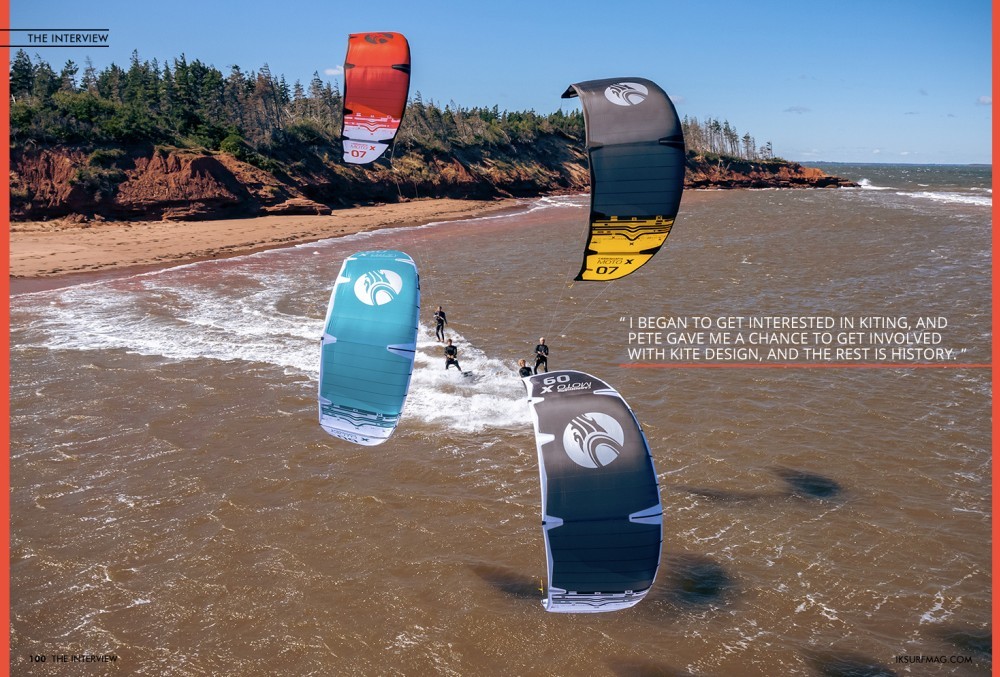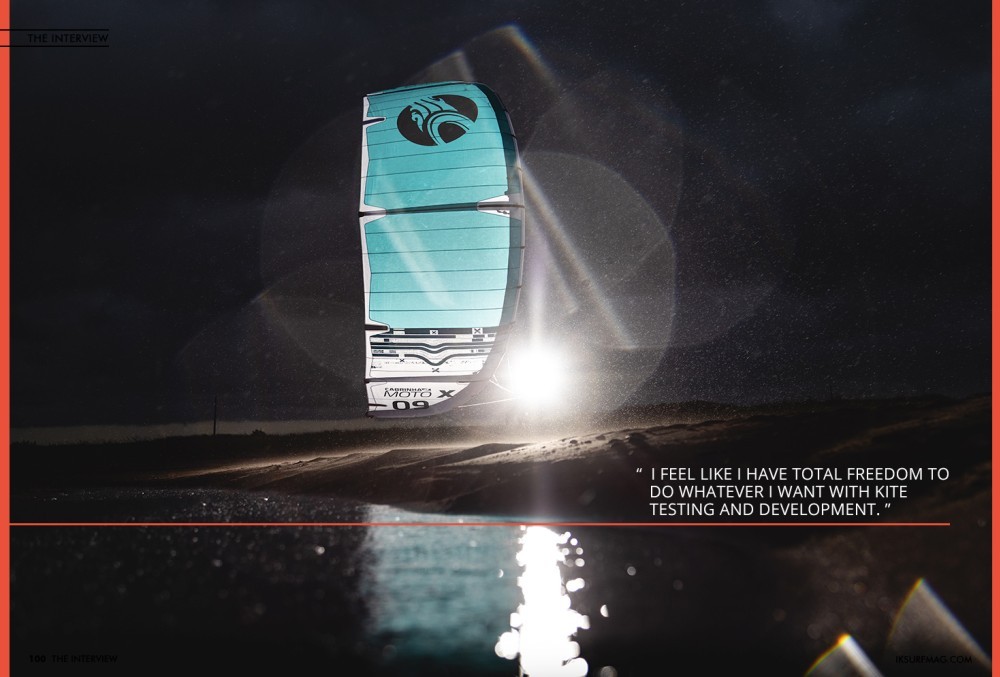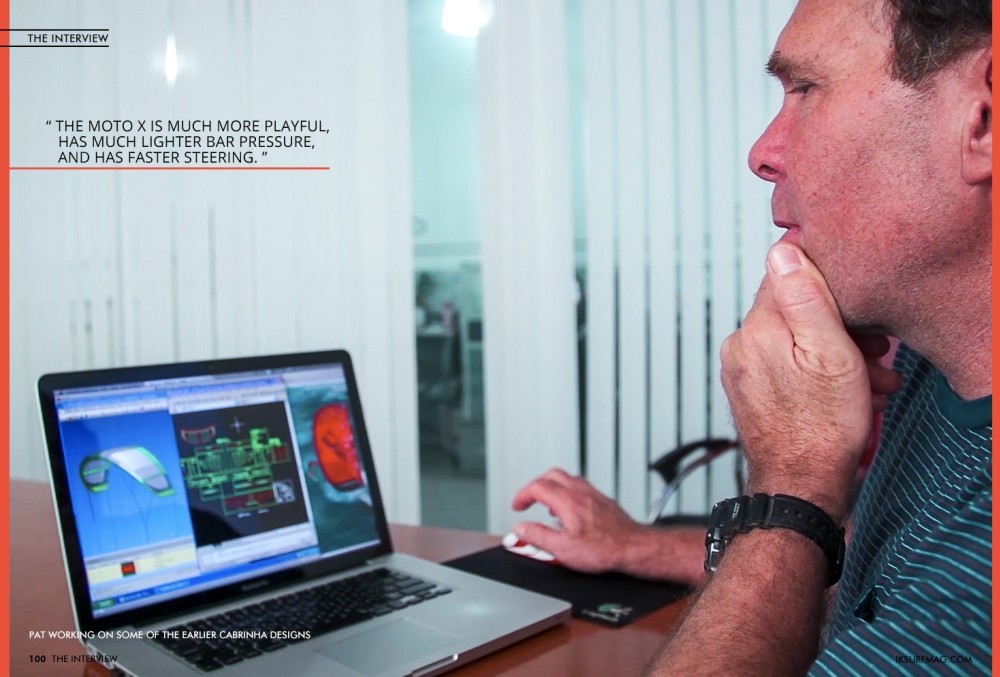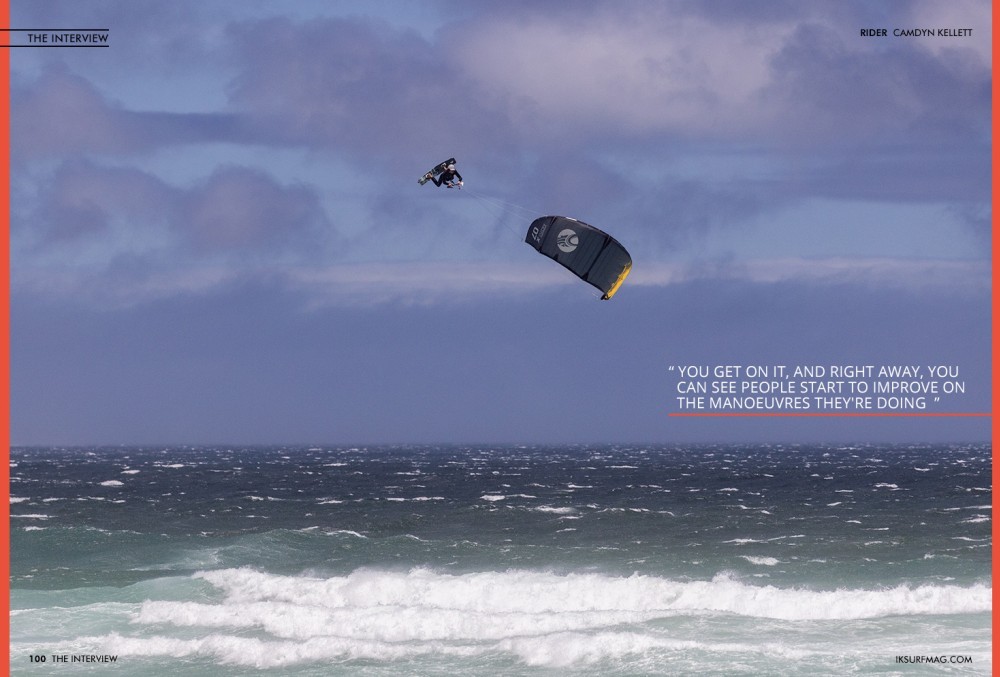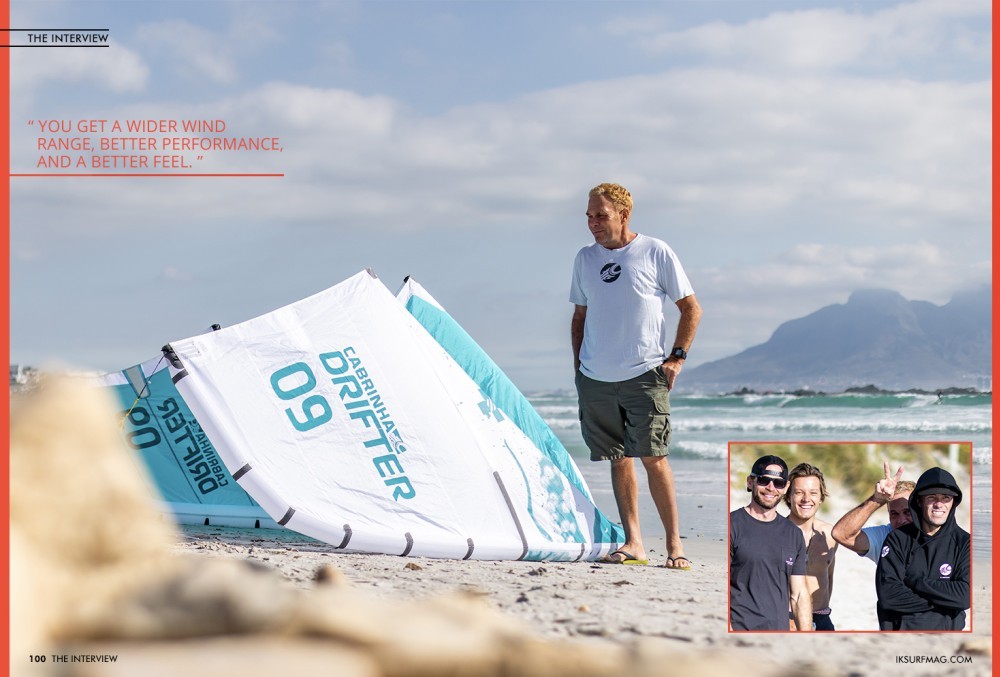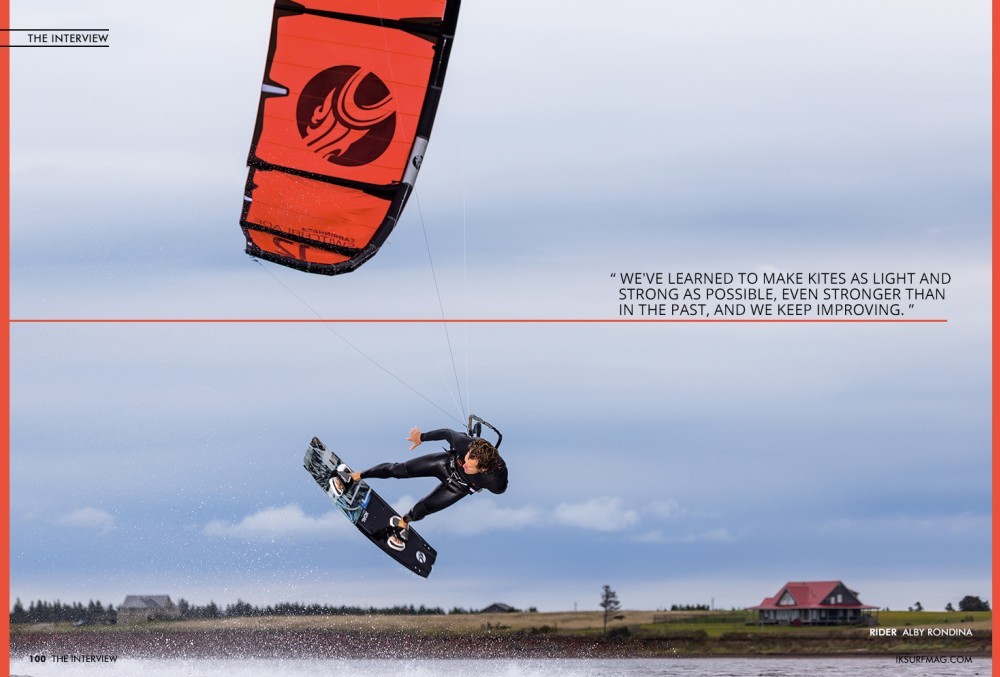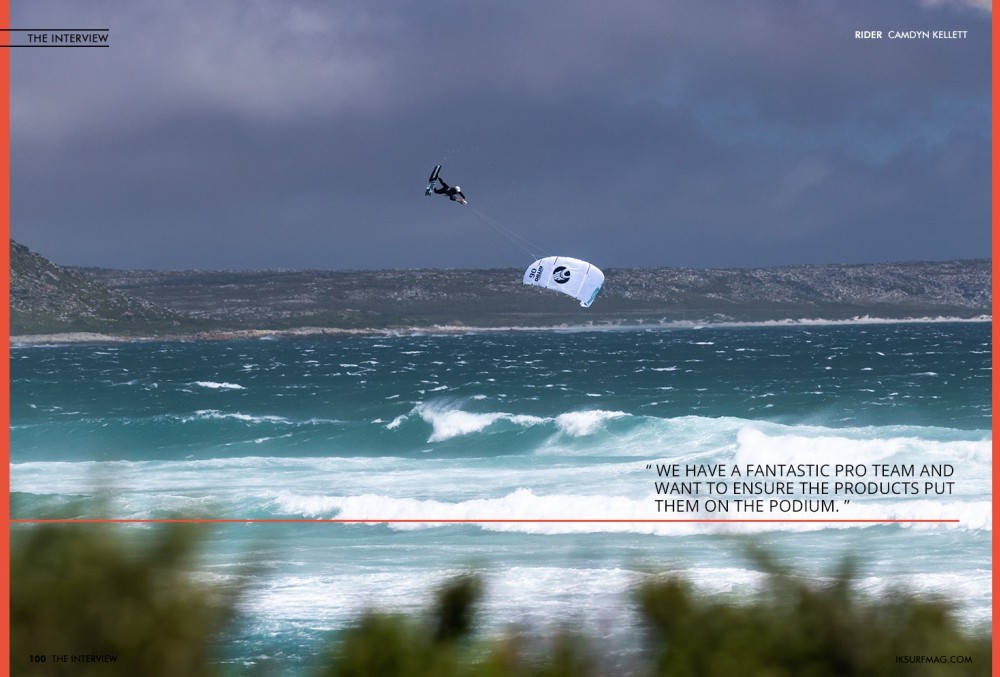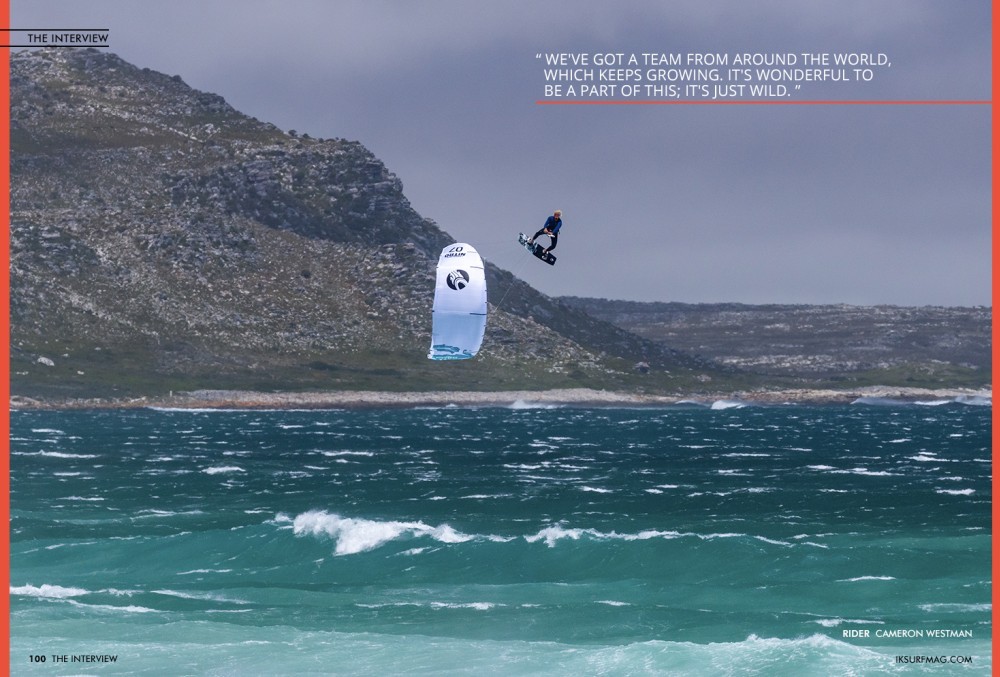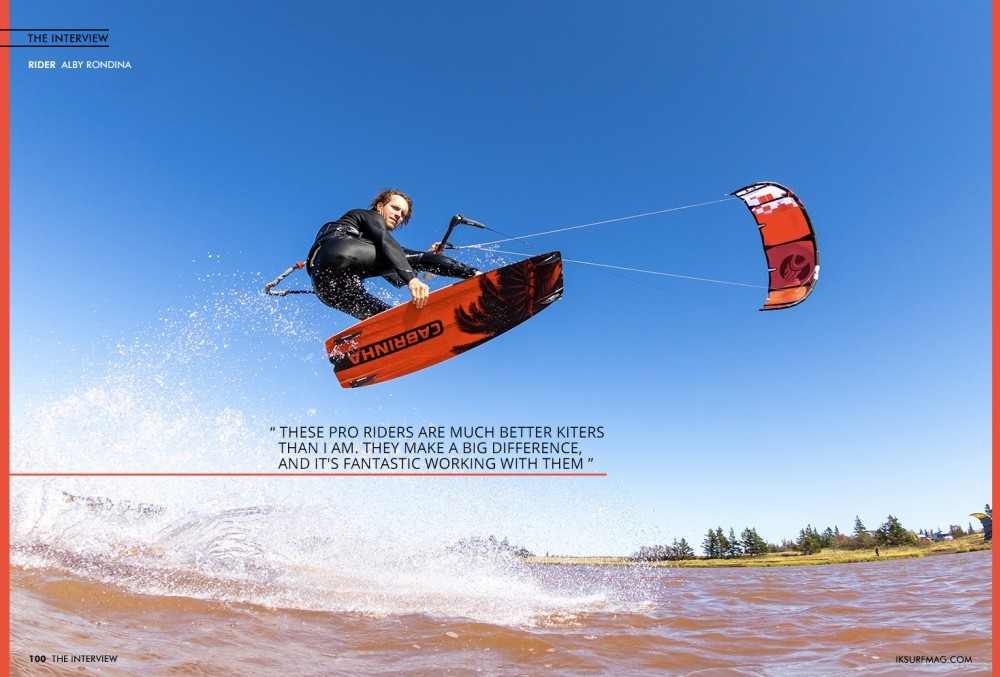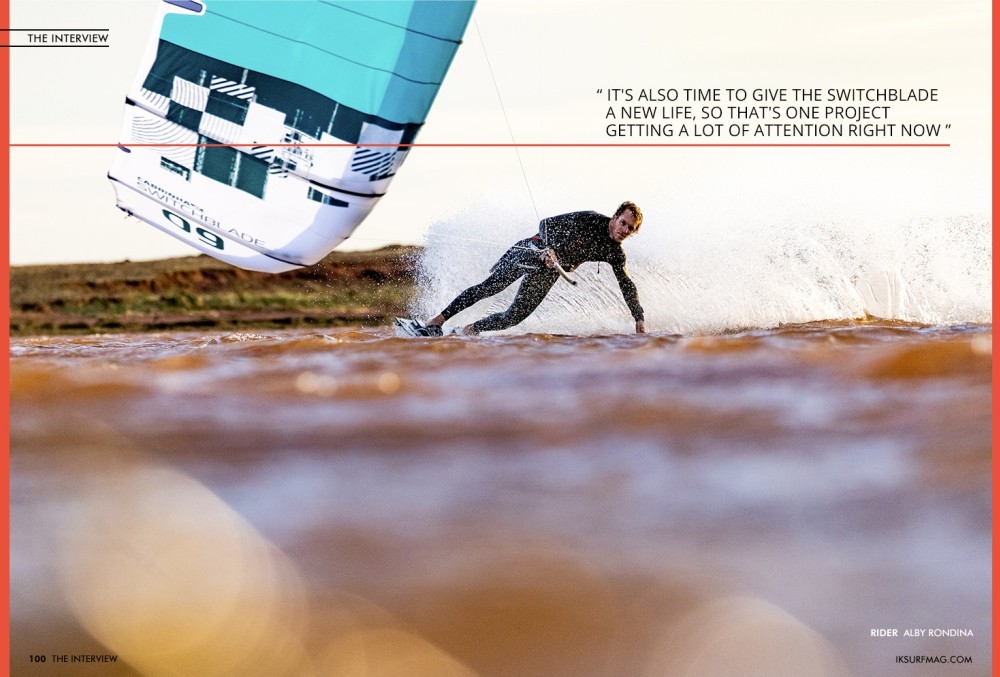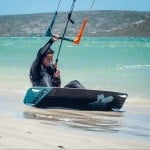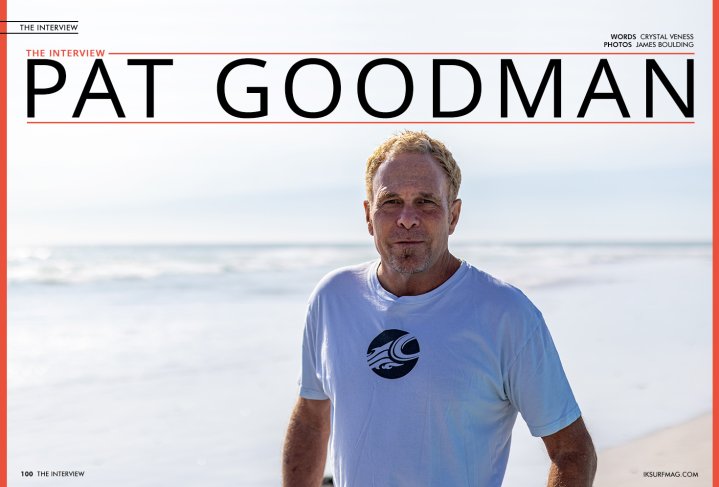
The Interview: Pat Goodman
Issue 100 / Wed 9th Aug, 2023
In this special 100th issue, we're getting to know one of the biggest icons behind the curtain of kiteboarding. You may not know his name, but you know his products. Meet Pat Goodman, the designer of one of the most popular kites of all time, the Cabrinha Switchblade. In The Interview, we hear about his start in the industry more than 20 years ago, the world of kite design in modern times, and what goes on behind the scenes at Cabrinha. Read it here, exclusively in IKSURFMAG!
Pat, it's great to catch up with you! You've had a long and storied career in the industry. How did you first link up with Cabrinha as a Kite Designer?
I worked with Neil Pryde as a designer doing windsurfing sails for several years and at Gaastra before then. Pete (Cabrinha) was a team rider at Gaastra, so we knew each other from way back. When the Pryde Group started the Cabrinha kite brand, Pete and his team moved into the same office as our design centre for windsurf sails. At that time, I began to get interested in kiting, and Pete gave me a chance to get involved with kite design, and the rest is history. I started as a Kite Designer in 2002, so it's been about 21 years.
At the time, I didn't have much experience with inflatable kites - nobody did, really! But we just took it from there. We hired another designer temporarily because he had kite design software that was the only thing available then, so we took him on as a consultant, and he helped out for the first couple of years. After that, in 2004, I took over the design of the kites exclusively.
You spent a few years with North Kiteboarding developing the much-loved Orbit and other popular kites in their lineup but returned to Cabrinha in 2021. What was it like coming back to the brand after the time away?
Yeah, as everybody knows, I took a sabbatical for a few years to help restructure North Kiteboarding, get their feet on the ground, and get their product line started. There are many reasons why I did that, but it was a bunch of my friends, and many of them also came from Cabrinha, and they needed some help. And it was time for a break and something new.
But, a few years ago, Cabrinha was restructured and purchased by another group, and the major shareholder in this group is a close friend of mine, Jon Modica. He was bugging me all those years I was away; he was like, "You gotta come back, you gotta come back!" At some point, I just decided it would be a lot of fun to come back and work with Jon. Cabrinha is a great brand with a credible reputation; everyone working here is very passionate about what they do. The factory is great, Jon's great, Lars, Dave, Phil, the whole group in the US, all these guys; it's a really cool group of people now, and with the new direction since change of ownership, there's a huge amount of resources going into product development.
Working with the brand is exciting now, as the motivation level is so high. It's really like a family, and even more so now because everybody here is my friend, and I've been working with them for 20-some-odd years. It's great coming back! I feel like I have total freedom to do whatever I want with kite testing and development. Of course, we have a strict design parameter and range plan to adhere to, but I also have a lot of freedom to try stuff on my own that I couldn't get anywhere else. I wouldn't want it any other way.
Tell us about the first product you designed that hit the market!
The first kites I did were the evolution of the Nitro and the Co2, both four-line kites at the time, though we experimented with five-line setups and many different things over the years. Those were the first kites I designed on the market. Then I was involved with the Crossbow and was the original designer of the Switchblade from the very start. We also had some consultation on the Crossbow, but after the first year, it became my product, and I moved it into another software and then evolved it from that point.
How about the most recent product you've worked on that's been released?
The Moto X is one of the latest kites we've designed from the ground up. It's an evolution of ideas that I've had over the years. We've always wanted to have a three-strut version of the Switchblade, but when I started experimenting with this, I found that we could make a much more fun and exciting kite to fly. The Moto X is a higher-performance kite in some ways than the Switchblade. The Switchblade, of course, has this fantastic wind range and stability that's hard to match with anything, but the Moto X is much more playful, has much lighter bar pressure, and has faster steering. Of course, the wind range is a little smaller than the Switchblade because it's a three-strut kite. There have been so many years of heavy bar pressure kites from Cabrinha because this was what we needed to do to get that maximum amount of depower for safety reasons. But, as things evolved, we were able to get the depower without the bar pressure.
With the Moto X, I wanted to make a statement that Cabrinha makes light, fun, fast, and exciting kites. We offer that firmer bar pressure option for entry-level and teaching and just because many people prefer having a lot of feedback from their kite. You can increase the feedback on the Moto X by moving to the B setting on the wingtip, but we found through testing and rider feedback that most people ride on the A setting because light and fast is what they're after, and that's where we're at with the Moto X. The introduction of a new high performing dacron called HTD-Lite has some incredible characteristics that's really helped give the Moto X some of its excitement and performance characteristics.
Do you think every designer has a signature style or a unique feel? If so, what sets a Pat Goodman design apart?
I would say that, yes, most of the kites out there have a signature feeling and style to the designers that created them. With the kites that I do, what you notice right away is you can hop on any of the kites I've designed, and it doesn't take long to get used to them. It's just a comfortable, predictable, at-home feeling - you get on it, and right away, you can see people start to improve on the manoeuvres they're doing because they feel super comfortable. I believe that is what sets our kites apart; there is no learning curve, no funny monkey business going on, they feel good, they're easy to get used to, and they perform well.
What are some of the differences in the world of kite design then versus now?
In modern times, kites have become cleaner, lighter and more responsive due to the evolution of software and materials. Working with the programmer developing the kite design software has been a long journey. We want to have control over every parameter of the kite, both aerodynamically and when dealing with the tension settings because kites change size when you pump them up. Everything elongates under pressure, so getting the kite in the sky to match the kite you see in the computer model is a big task. Anybody can make a kite look pretty in the design software, but unless you know how to make wings from flexible materials, it won't look or behave like it should. So, you have to master that first, and you can then start tracking your data and work on the actual performance.
The materials have developed a lot, too. We've worked with manufacturers and developed several materials specifically for kite-inflated parts, so there's been a vast improvement. We've been focusing on materials that are lighter but still strong with the kind of dynamics we're looking for. The elongation is much less now than it used to be, making things much better and cleaner. When your kite is clean with less deformation or creases in the front of the canopy, you get a wider wind range, better performance, and a better feel. When I go out, I can feel if a kite is not working as well as it should - and that's due to materials and software and 21 years of dealing with making wings from flexible materials.
Have construction techniques changed significantly over the years?
Today's construction techniques are based on the way it all started back in 2002, so it's not massively different, but there's no question that construction methods have evolved along with the software and materials. We've learned to make kites as light and strong as possible, even stronger than in the past, and we keep improving.
For example, with earlier kites, most of the seams in the leading edge and canopy of the kite were sewn freehand. The machines had a guide on them to control the seam allowance, but it was up to the operator to ensure that the pieces matched and came out the same length by the time they got to the end of the seam. There was a lot of dependency on the skill of the sewing machine operator, which made for some irregularities from kite to kite. Now, we use more adhesives to not only improve the strength of the seams but to stick everything together so that they're aligned and checked before they get sewn. Everything is stuck together, pieces of the canopy, struts, the leading edge, and even the canopy to the struts. Today, virtually anybody can sew the seams because the skill has transferred to the people sticking the seams. There are several points of reference for alignment, so if it's not perfect, they can pull it apart before it's sewn, re-stick it, and get it right. There's no freehand sewing left anymore; it's all done with adhesives that keep it all accurate because accuracy is the key to everything.
Tell us a bit about Cab Design Works! What's it like working with so many experienced and up-and-coming product developers?
With Cab Design Works, there are a lot of new people on the engineering side of things, especially in board development. We've got Dean, John, and Brodie, and there are a lot of really smart, young, fired-up guys in here with great ideas that are passionate about the sport. Everybody kites, including the owner, but the skill level of these guys is really good. I'm old school; I'm really good at feeling and testing kites, but I'm not super hot with the tricks and stuff. But these guys are on another level with their kiting and winging skills, and every one of them is an engineer, too, with 3D CAD skills; I mean, wow, this is definitely the next generation. Now we've got a blend of old school and new school, and we put it all together and come up with some very cool stuff. It's great; I'm learning from them, and they're learning from me. There's no question; it's all pretty cool.
How many designers do you collaborate with? How does the team approach to product development work?
The amount of people involved fluctuates from time to time, but basically, the internal design team does most of the preliminary testing to get the products to where we feel it meets the demand of the design brief. Everybody has their say and input on the kite designs, as far as our design team and development team, but the bulk of the actual design is done by myself with feedback from the other guys.
At the end of the day, your product is only as good as your test team, and what makes a big difference is Phil Sobolev and his ability to give valuable and constructive feedback. He and the riders that are involved in the testing have to be able to disagree with me if they're feeling something different. We've got riders for every discipline and genre of the sport, and we use them all at different times with different products. And then, we get the more high-end team riders involved and ensure that the equipment meets their demands to get on the podium.
It's amazing to work in the product development end of Cabrinha. We've got a team from around the world, which keeps growing. It's wonderful to be a part of this; it's just wild. I have hundreds of friends worldwide that were brought together by this common interest, passion, and love of kitesurfing, making the best product we can and making other people smile.
One of the most significant product releases from Cabrinha in recent years is the all-new Nitro. What insights can you share on this exciting new design?
The Nitro has been an exciting project. My experience during my sabbatical was getting a big air kite on the podium; we did really well with that. The big challenge with making a big air kite for Cabrinha was to ensure it wasn't just another Orbit. I put a lot of focus on creating a better-performing kite that was more fun, fast, exciting, and playful to fly, but still with the attributes of getting the best altitude and hangtime possible. Steering is also important because these guys are now throwing more double and even triple kite loops.
The Nitro is a challenging project in some ways, compared to a freeride kite like the Moto, which is more subjective to the personal feelings of the rider. You're always going to have a certain percentage of people that love them and a small percentage that don't, and it's based on the feeling that they're used to and what they want to feel from the kite, and their experience has to be fun.
A kite like the Nitro has to jump high, have good hangtime, and loop and catch you properly. We chase these attributes in all kites, but the team had more of a carte blanche approach on the Nitro in particular. It's one reason we implemented a new dacron material called Ultra-HT on it, the only kite in the range with this. Its killer property, while also being lighter than our HTD dacron, is its incredibly low elongation and response. In big air, riders tend to hold a lot more power down, and there is so much more force on the kite through the jump and loop.
How is working with the pro team? Do these athletes provide a lot of input when finetuning designs?
In many cases, their feeling with a kite is different than what I feel because they're at such another level, and they ride the kites in so much more wind than I can hold down. It's just unbelievable how lit they're riding all the time. When I'm all concerned about bar pressure, they're more concerned about depower and management when riding an 8m kite in close to 40 knots.
On a kite like the Moto X, I take feedback from every rider and try to make everyone happy all the time, which is impossible as we're dealing with many different locations, people, weights, skill levels, etc. In a kite like the Nitro, the final decision about the feel of the kite is 100% in the hands of the team riders, so their feedback is super important. They are a specialised target group with a specific outcome in mind, and these pro riders are much better kiters than I am. They make a big difference, and it's fantastic working with them. We couldn't do it without them.
What product(s) are you working on now that you can talk about? Anything exciting on the horizon that you can share with us?
I'm working on all sorts of new stuff; everything's evolving. There were quite a few products this last year that were revised drastically when I came back. We have a new Drifter, Moto X, and the Nitro. The Nitro is going into its second generation now, so lots of time and effort is being put into making that kite even better. We have a fantastic pro team and want to ensure the products put them on the podium.
It's also time to give the Switchblade a new life, so that's one project getting a lot of attention right now. It will still have the DNA of a Switchblade because it's such a legendary kite that we can't steer too far away from, but it's a much more fun and pleasing kite to fly with this new design I'm working on. It won't lose this park-and-ride, predictable feeling that the Switchblade has always had, but it will have the option for lighter bar pressure and faster steering.
We're experimenting with a lot of new materials, which make a difference in the weight, handling and behaviour of our kites, and we're trying these new materials on a bunch of different kites in the range. I can't tell you what they are, but it makes a difference. Some other projects are not public at the moment, but all sorts of new stuff will be coming out in 2024. There will be some head-turners with what we will put out there that will make a difference and keep Cabrinha on the top. Keep your eyes out after the New Year, as this is when these products will be dropping!
Videos
By Crystal Veness
Editor at IKSURFMAG, Crystal Veness hails from Canada but is based in South Africa. When she isn't busy kitesurfing or reporting on the latest industry news for the mag, she is kicking back somewhere at a windy kite beach or working on creative media projects.




